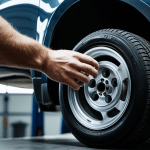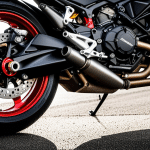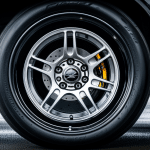Understanding the Serpentine Belt in Luxury SUVs
The serpentine belt is crucial to the functioning of luxury SUVs. It powers essential components such as the alternator, power steering pump, and air conditioning compressor. Luxury SUV maintenance becomes critical as these vehicles often incorporate advanced technology and systems. Recognizing the importance of this often-overlooked component ensures that these systems operate smoothly.
Signs of serpentine belt wear can include a squealing noise from the front of the vehicle, cracks or visible wear on the belt itself, and the loss of power to vehicle systems like air conditioning or power steering. Addressing these symptoms promptly not only aids in preventing roadside breakdowns but also helps in avoiding potentially costly repairs.
A découvrir également : Exposing Hidden Dangers: How Illegal Car Mods Affect UK Drivers
Interestingly, luxury SUVs sometimes feature unique serpentine belt designs compared to standard vehicles. The complexities of high-end models might include multiple belts working in tandem or the use of specialized materials for enhanced durability and efficiency. Understanding these differences is vital for owners and mechanics to provide proper care and servicing.
The combination of belt functionality and distinctive design characteristics reflects why routine checking and maintenance are vital to extend the longevity and reliability of luxury SUVs.
Sujet a lire : How Bigger Wheels Enhance Safety in Compact City Cars: An In-Depth Analysis
Tools and Materials Required for Replacement
Replacing the serpentine belt in a luxury SUV requires careful consideration of the right DIY tools and materials. Having the correct automotive tools can make the process smoother and more efficient. Below is an overview of the essentials needed for a typical replacement:
Essential Tools:
- Socket and wrench set – Useful for loosening and tightening bolts during the process.
- Belt tensioner tool – Critical for releasing the tension on the existing belt and properly fitting the new one.
- Ratchet with various extensions – To effectively reach tight spaces within the engine compartment.
Recommended Materials:
- A new serpentine belt that matches the specific model of your luxury SUV.
- Replacement pulleys or tensioner, if worn or damaged.
Before starting the replacement, ensure you have the correct belt specifications for your vehicle. This involves checking the make, model, and engine type specifics. Mismatched parts can lead to poor performance or immediate failure. Ensuring the right specifications not only aids in a seamless replacement but also enhances the longevity and performance of your luxury vehicle. Proper preparation and having these tools at your disposal are crucial for a successful serpentine belt replacement.
Step-by-Step Guide to Replacing the Serpentine Belt
Proper serpentine belt replacement ensures continued performance in your luxury SUV. This step-by-step guide covers essential processes to keep your vehicle in top condition.
Preparing Your Workspace
Before beginning the replacement guide, prioritise safety. Disconnect the battery to prevent electrical hazards and wear safety gear like goggles and gloves. Organise your automotive tools within easy reach, including socket sets and belt tensioner tools, ensuring a smooth workflow.
Removing the Old Serpentine Belt
To remove the existing belt in a luxury SUV repair, locate the belt tensioner and use a belt tensioner tool to relieve tension. Slide the belt off the pulleys carefully, ensuring not to damage any components. Document the belt’s pathway, as different models have unique designs.
Installing the New Serpentine Belt
With the new serpentine belt, align it as per the documented pathway. Place the belt around each pulley, maintaining even tension. Use the belt tensioner to adjust for a secure fit. Double-check for correct alignment and tension, critical for maintaining belt functionality and overall vehicle performance. Proper installation enhances the belt’s efficiency and longevity, playing a pivotal role in luxury SUV maintenance.
Safety Tips During the Replacement Process
When tackling a serpentine belt replacement in luxury SUVs, prioritising safety precautions is crucial to ensure a hassle-free experience. Understanding the role of vehicle safety can significantly reduce risks associated with this automotive task.
Importance of Safety Gear and Equipment
Wearing appropriate safety gear is imperative. Essential items include safety goggles to protect against debris and gloves to prevent injuries from harsh vehicle components. Also, using a sturdy floor jack and stands can stabilise the vehicle, enhancing safety during the process.
Common Hazards to Be Aware Of
In the world of automotive repair tips, recognising potential hazards like sharp edges and moving parts can prevent accidents. Be vigilant about hot engine components if the vehicle has been recently used, reducing burn risks.
Tips for Working with Automotive Parts Safely
Approach each task methodically; do not rush. Double-check all tools and ensure proper functionality before use. Use a well-lit workspace to improve visibility and reduce the chance of errors when handling small components. Working with caution not only safeguards you but also contributes to effective and efficient maintenance, preserving vehicle integrity.
Maintenance Advice for Luxury SUVs
Proper luxury vehicle maintenance ensures that your investment remains in prime condition. A pivotal component of this is serpentine belt care. Regular inspection and maintenance of the serpentine belt play a vital role in vehicle longevity. Routine checks are recommended every 30,000 miles, with replacements typically suggested between 60,000 to 100,000 miles, depending on the vehicle’s use and environment.
Signs indicating the need to check or replace the serpentine belt include visible cracks, fraying, or a squealing sound from the engine area. These symptoms demand immediate attention to prevent failures in vehicle systems powered by the belt, such as air conditioning and power steering.
The benefits of regular inspections are manifold. They minimize the risk of costly breakdowns and ensure that the luxury SUV operates efficiently. Maintaining the belt’s condition not only conserves functionality but also boosts fuel economy and prolongs the lifespan of other connected components. In sum, consistent serpentine belt care not only safeguards engine integrity but also assures the top-tier performance synonymous with luxury SUVs.
Common Brands and Models of Luxury SUVs in the UK
The UK market hosts a wide range of luxury SUV brands renowned for their sophistication and performance. Leading the pack are Land Rover, BMW, Mercedes-Benz, and Audi, each offering models that exemplify engineering excellence and design innovation. These brands focus on meeting the specific demands of UK consumers, where road conditions and climate can influence vehicle specifications and performance.
In terms of model specifications, it’s crucial to understand the serpentine belt requirements for each brand. For instance, the Range Rover, a staple of Land Rover, often features heavy-duty belts designed to cope with off-road challenges and various weather conditions. Similarly, the BMW X5 and Audi Q7 boast intricate serpentine belt systems that demand precision and special attention during maintenance to ensure optimal operation.
An understanding of these models’ specific belt functionality is key to maintaining vehicle efficiency. Industry trends in the UK lean towards SUVs with hybrid and electric options, reflecting a growing consumer preference for greener technologies while expecting the robust performance typical of traditional luxury SUVs. These preferences impact both initial purchase decisions and ongoing luxury SUV maintenance.
Regional Specifics and Regulations
Navigating the UK vehicle regulations can be a complex task, especially concerning luxury SUV maintenance. Understanding these laws ensures both compliance and optimal vehicle performance. In the UK, automotive laws specify regular inspections for critical components like the serpentine belt, crucial for maintaining overall vehicle longevity. These regulations demand that safety standards are met, impacting both maintenance schedule and quality requirements.
Regional requirements can vary significantly, particularly regarding professional versus DIY work. For instance, while DIY tools can be used for basic checks, certain aspects might legally necessitate qualified professionals for major replacements, ensuring adherence to safety protocols. This delineation highlights the need to recognise when a task surpasses the scope of casual maintenance, requiring expert intervention.
Moreover, these regulations directly influence luxury SUV maintenance practices, shaping how and when maintenance is performed. Understanding such mandates is essential for owners to make informed decisions on servicing their vehicles. Adhering to these regional specifics not only guarantees compliance but also enhances the reliability and safety of luxury SUVs, thereby safeguarding your investment while enriching driving experiences.






